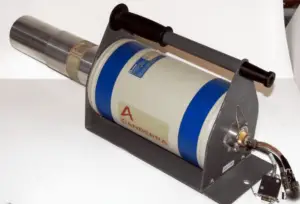
The major drawback of germanium detectors is that they must be cooled to liquid nitrogen temperatures. Because germanium has relatively low band gap, these detectors must be cooled in order to reduce the thermal generation of charge carriers to an acceptable level. Otherwise, leakage current induced noise destroys the energy resolution of the detector. Recall, the band gap (a distance between valence and conduction band) is very low for germanium (Egap= 0.67 eV). Cooling to liquid nitrogen temperature (-195.8°C; -320°F) reduces thermal excitations of valence electrons so that only a gamma ray interaction can give an electron the energy necessary to cross the band gap and reach the conduction band.
Therefore, HPGe detectors are usually equipped with a cryostat. Germanium crystals are maintained within an evacuated metal container referred to as the detector holder. The detector holder as well as the “end-cap” are thin to avoid attenuation of low energy photons. The holder is generally made of aluminum and is typically 1 mm thick. The end-cap, is also generally made of aluminum. The HPGe crystal inside the holder is in thermal contact with a metal rod called a cold finger. The cold finger transfers heat from the detector assembly to the liquid nitrogen (LN2) reservoir. The combination of the vacuum metal container, the cold finger and the Dewar flask for the liquid nitrogen cryogen is called the cryostat. The germanium detector preamplifier is normally included as part of the cryostat package. Since the preamp should be located as close as possible so that the overall capacitance can be minimized, the preamp is installed together. The input stages of the preamp are also cooled. The cold finger extends past the vacuum boundary of the cryostat into a Dewar flask that is filled with liquid nitrogen. The immersion of the cold finger into the liquid nitrogen maintains the HPGe crystal at a constant low temperature. The temperature of the liquid nitrogen is held constant at 77 K (-195.8°C; -320°F) by slow boiling of the liquid, resulting in the evolution of nitrogen gas. Depending on the size and design, the holding time of vacuum flasks ranges from a few hours to a few weeks.
Cooling with liquid nitrogen is inconvenient, as the detector requires hours to cool down to operating temperature before it can be used, and cannot be allowed to warm up during use. HPGe detectors can be allowed to warm up to room temperature when not in use. It must be noted, Ge(Li) crystals could never be allowed to warm up, as the lithium would drift out of the crystal, ruining the detector.
Commercial systems became available that use advanced refrigeration techniques (for example a pulse tube cooler) to eliminate the need for liquid nitrogen cooling. This cooling system is an electrically powered cryostat, completely LN2 free.
See also: Germanium Detectors, MIRION Technologies. <available from: https://www.mirion.com/products/germanium-detectors>.
We hope, this article, Part of HPGe Detectors – Holder – Cold Finger, helps you. If so, give us a like in the sidebar. Main purpose of this website is to help the public to learn some interesting and important information about radiation and dosimeters.